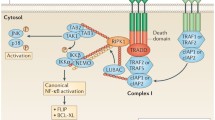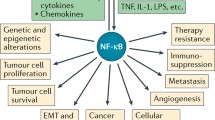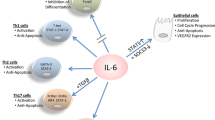Abstract
Tumour necrosis factor alpha is a member of the TNF/TNFR cytokine superfamily. In common with other family members, TNF-α is involved in maintenance and homeostasis of the immune system, inflammation and host defence. However, there is a ‘dark side’ to this powerful cytokine; it is now clear that, especially in middle and old age, TNF-α is involved in pathological processes such as chronic inflammation, autoimmunity and, in apparent contradiction to its name, malignant disease. This article will discuss the involvement of TNF-α in the inflammatory network that contributes to all stages of the malignant process, and consider the possibility that TNF-α may be a target for cancer therapy.
Similar content being viewed by others
References
Akira, S., & Takeda, K. (2004). Toll-like receptor signalling. Nature Reviews. Immunology, 4, 499–511.
Arnott, C. H., Scott, K. A., Moore, R. J., Hewer, A., Phillips, D. H., Parker P., et al. (2002). Tumour necrosis factor-α mediates tumour promotion via a PKCα-AP-1-dependent pathway. Oncogene, 21, 4728–4738.
Arnott, C. H., Scott, K. A., Moore, R. J., Robinson, S. C., Thompson, R. G., & Balkwill, F. R. (2004). Expression of both TNF-α receptor subtypes is essential for optimal skin tumour development. Oncogene, 23, 1902–1910.
Balkwill, F. (2002). Tumor necrosis factor or tumor promoting factor? Cytokine & Growth Factor Reviews, 13, 135–141.
Balkwill, F. (2004). The significance of cancer cell expression of CXCR4. Seminars in Cancer Biology, 14, 171–179.
Balkwill, F., & Mantovani, A. (2001). Inflammation and cancer: Back to Virchow. Lancet, 357, 539–545.
Balkwill, F., Charles, K. A., & Mantovani, A. (2005). Smoldering and polarized inflammation in the initiation and promotion of malignant disease. Cancer Cell, 7, 211–217.
Bates, R. C., & Mercurio, A. M. (2003). Tumor necrosis factor-α stimulates the epithelial-to-mesenchymal transition of human colonic organoids. Molecular Biology of the Cell, 14, 1790–1800.
Bozcuk, H., Uslu, G., Samur, M., Yildiz, M., Ozben, T., Ozdogan, M., et al. (2004). Tumour necrosis factor-alpha, interleukin-6, and fasting serum insulin correlate with clinical outcome in metastatic breast cancer patients treated with chemotherapy. Cytokine, 27, 58–65.
Chakravarty, E. F., Michaud, K., & Wolfe, F. (2005). Skin cancer, rheumatoid arthritis, and tumor necrosis factor inhibitors. Journal of Rheumatology, 32, 2130–2135
Coussens, L. M., & Werb, Z. (2002). Inflammation and cancer. Nature, 420, 860–867.
Feldmann, M. (2002). Development of anti-TNF therapy for rheumatoid arthritis. Nature Reviews Immunology, 2, 364–371.
Ferrajoli, A., Keating, M. J., Manshouri, T., Giles, F. J., Dey, A., Estrov, Z., et al. (2002). The clinical significance of tumor necrosis factor-α plasma level in patients having chronic lymphocytic leukemia. Blood, 100, 1215–1219.
Galban, S., Fan, J., Martindale, J. L., Cheadle, C., Hoffman, B., Woods, M. P., et al. (2003). von Hippel-Lindau protein-mediated repression of tumor necrosis factor alpha translation revealed through use of cDNA arrays. Molecular & Cellular Biology, 23, 2316–2328.
Glasmacher, A., & von Lilienfeld-Toal, M. (2005). The current status of thalidomide in the management of multiple myeloma. Acta Haematologica, 114, 3–7.
Greten, F. R., Eckman, L., Greten, T. F., Park, J. M., Li, Z-W., Egan, L. J., et al. (2004). IKKβ links inflammation and tumorigenesis in a mouse model of colitis-associated cancer. Cell, 118, 285–296.
Grivennikov, S. I., Tumanov, A. V., Liepinsh, D. J., Kruglov, A. A., Marakusha, B. I., Shakhov, A. N., et al. (2005). Distinct and nonredundant in vivo functions of TNF produced by T cells and macrophages/neutrophils: Protective and deleterious effects. Immunity, 22, 93–104.
Hagemann, T., Robinson, S. C., Schulz, M., Trumper, L., Balkwill, F. R., & Binder, C. (2004). Enhanced invasiveness of breast cancer cell lines upon co-cultivation with macrophages is due to TNF-α dependent upregulation of matrix metalloproteases. Carcinogenesis, 25, 1543–1549.
Hagemann, T., Wilson, J., Li, N. F., Leinster, A., Charles, K. A., Kulbe, H., et al. (2005). Macrophages induce invasiveness of epithelial cancer cells via NFκB and JNK. Journal of Immunology, 174(2), 1197–1205.
Hehlgans, T., & Pfeffer, K. (2005). The intriguing biology of the tumor necrosis factor/tumour necrosis factor receptor superfamily: Players, rules and the games. Immunology, 115, 1–20.
Hildebrandt, G. C., Olkiewicz, K. M., Corrion, L. A., Chang, Y., Clouthier, S. G., Liu, C., et al. (2004). Donor-derived TNF-α regulates pulmonary chemokine expression and the development of idiopathic pneumonia syndrome after allogeneic bone marrow transplantation. Blood, 104, 586–593.
Iocca, H. A., & Isom, H. C. (2003). Tumor necrosis factor-α acts as a complete mitogen for primary rat hepatocytes. American Journal of Pathology, 163, 465–476.
Karayiannakis, A. J., Syrigos, K. N., Polychronidis, A., Pitiakoudis, M., Bounovas, A., & Simopoulos, K. (2001). Serum levels of tumor necrosis factor-alpha and nutritional status in pancreatic cancer patients. Anticancer Research, 21, 1355–1358.
Keane, J., Gershon, S., Wise, R. P., Mirabile-Levens, E., Kasznica, J., Schwieterman, W. D., et al. (2001). Tuberculosis associated with infliximab, a tumor necrosis factor α-neutralizing agent. New England Journal of Medicine, 345, 1098–1104.
Kitakata, H., Nemoto-Sasaki, Y., Takahashi, Y., Kondo, T., Mai, M., & Mukaida, N. (2002). Essential roles of tumor necrosis factor receptor p55 in liver metastasis of intrasplenic administration of colon 26 cells. Cancer Research, 62, 6682–6687.
Knight, B., Yeoh, G. C. T., Husk, K. L., Ly, T., Abraham, L. J., Yu, C., et al. (2000). Impaired preneoplastic changes and liver tumor formation in tumor necrosis factor receptor type 1 knockout mice. Journal of Experimental Medicine, 192, 1809–1818.
Komori, A., Yatsunami, J., Suganuma, M., Okabe, S., Abe, S., Sakai, A., et al. (1993). Tumor necrosis factor acts as a tumor promoter in BALB/3T3 cell transformation. Cancer Research, 53, 1982–1985.
Kontoyiannis, D., Pasparakis, M., Pizarro, T. T., Cominelli, F., & Kollias, G. (1999). Impaired on/off regulation of TNF biosynthesis in mice lacking TNF AU-rich elements: Implications for joint and gut-associated immunopathologies. Immunity, 10, 387–398.
Korner, H., Cretney, E., Wilhelm, P., Kelly, J. M., Rollinghoff, M., Sedgwick, J. D., & et al. (2000). Tumor necrosis factor sustains the generalized lymphoproliferative disorder (gld) phenotype. Journal of Experimental Medicine, 191, 89–96.
Kulbe, H., Hagermann, T., Szlosarek, P. W., Balkwill, F. R., & Wilson, J. L. (2005). The inflammatory cytokine TNF-a upregulates chemokine receptor expression on ovarian cancer cells. Cancer Research, 65, 10355–10362.
Kuprash, D. V., Tumanov, A. V., Liepinsh, D. J., Koroleva, E. P., Drutskaya, M. S., Kruglov, A. A., et al. (2005). Novel tumor necrosis factor-knockout mice that lack Peyer’s patches. European Journal of Immunology, 35, 1592–1600.
Kyriakou, C., Thomson, K., D’Sa, S., Flory, A., Hanslip, J., Goldstone, A. H., et al. (2005). Low-dose thalidomide in combination with oral weekly cyclophosphamide and pulsed dexamethasone is a well tolerated and effective regimen in patients with relapsed and refractory multiple myeloma. British Journal of Haematology, 129, 763–770.
Lejeune, F. J. (2002). Clinical use of TNF revisited: Improving penetration of anti-cancer agents by increasing vascular permeability. Journal of Clinical Investigation, 110, 433–435.
Locksley, R. M., Killeen, N., & Lenardo, M. J. (2001). The TNF and TNF receptor superfamilies: Integrating mammalian biology. Cell, 104, 487–501.
Lu, T., & Stark, G. R. (2004). Cytokine overexpression and constitutive NFκB in cancer. Cell Cycle, 3, e69–e72.
Luo, J. L., Maeda, S., Hsu, L. C., Yagita, H., & Karin, M. (2004). Inhibition of NFD-kappaB in cancer cells converts inflammation-induced tumor growth mediated by TNFalpha to TRAIL-mediated tumor regression. Cancer Cell, 6, 297–305.
Madhusudan, S., Foster, M., Braybrooke, J., Muthuramalingham, S. R., Wilner, S., Kaur, K. et al. (2004). A phase II study of Etanercept (Enbrel), a tumour necrosis factor-a inhibitor in patients with metastatic breast cancer. Clinical Cancer Research, 10, 6528–6534.
Madhusudan, S., Muthuramalingam, S. R., Braybrooke, J. P., Wilner, S., Kaur, K., Han, C., et al. (2005). A phase II study of Ethanercept (ENBREL) a tumour necrosis factor-a inhibitor in recurrent ovarian cancer. Journal of Clinical Oncology, 10, 6528–6534.
Maeda, S., Kamata, H., Luo, J. L., Leffert, H., & Karin, M. (2005). IKKbeta couples hepatocyte death to cytokine-driven compensatory proliferation that promotes chemical hepatocarcinogenesis. Cell, 121, 977–990.
Malik, S. T. A., Naylor, S., East, N., Oliff, A., & Balkwill, F. R. (1990). Cells secreting tumour necrosis factor show enhanced metastasis in nude mice. European Journal of Cancer, 26, 1031–1034.
McDermott, M. F. (2001). TNF and TNFR biology in health and disease. Cellular and Molecular Biology, 47, 619–635.
Michalaki, V., Syrigos, K., Charles, P., & Waxman, J. (2004). Serum levels of IL-6 and TNF-alpha correlate with clinicopathological features and patient survival in patients with prostate cancer. British Journal of Cancer, 91, 1227.
Micheau, O., & Tschopp, J. (2003). Induction of TNF receptor I-mediated apoptosis via two sequential signaling complexes. Cell, 114, 181–190.
Moore, R., Owens, D., Stamp, G., East, N., Holdworth, H., Arnott, C., et al. (1999). Tumour necrosis factor-a deficient mice are resistant to skin carcinogenesis. Nature Medicine, 5, 828–831.
Nabors, L. B., Suswam, E., Huang, Y., Yang, X., Johnson, M. J., & King, P. H. (2003). Tumor necrosis factor α induces angiogenic factor up-regulation in malignant glioma cells: A role for RNA stabilization and HuR. Cancer Research, 63, 4181–4187.
Orosz, P., Echtenacher, B., Falk, W., Ruschoff, J., Weber, D., & Mannel, D. N. (1993). Enhancement of experimental metastasis by tumor necrosis factor. Journal of Experimental Medicine, 177, 1391–1398.
Orosz, P., Kruger, A., Hubbe, M., Ruschoff, J., Von Hoegen, P., & Mannel, D. N. (1995). Promotion of experimental liver metastasis by tumor necrosis factor. International Journal of Cancer, 16, 867–871.
Pasparakis, M., Alexopoulou, L., Grell, M., Pfizenmaier, K., Bluethmann, H., & Kollias, G. (1997). Peyer’s patch organogenesis is intact yet formation of B lymphocyte follicles is defective in peripheral lymphoid organs of mice deficient for tumor necrosis factor and its 55-kDa receptor. Proceedings of the National Academy of Sciences of the United States of America, 94, 6319–6323.
Perkins, N. D. (2004). NF-κB: Tumor promoter or suppressor? Trends in Cell Biology, 14, 64–69.
Pfitzenmaier, J., Vessella, R., Higano, C. S., Noteboom, J. L., Wallace, D. Jr., & Corey, E. (2003). Elevation of cytokine levels in cachectic patients with prostate carcinoma. Cancer, 97, 1211–1216.
Pikarsky, E., Porat, R. M., Stein, I., Abramovitch, R., Amit, S., Kasem, S. et al. (2004). NF-κB functions as a tumour promoter in inflammation-associated cancer. Nature, 431, 4461–4466.
Raza, A., Candoni, A., Khan, U., Lisak, L., Tahir, S., Silvestri, F. et al. (2004). Remicade as TNF suppressor in patients with myelodysplastic syndromes. Leukemia & Lymphoma, 45, 2099–2104.
Reich, K., Nestle, F. O., Papp, K., Ortonne, J.-P., Evans, R., Guzzo, C., et al. (2005). Infliximab induction and maintenance therapy for moderate-to-severe psoriasis: A phase III, multicentre, double-blind trial. Lancet, 366, 1367–1374.
Schluter, D., Kwok, L.-Y., Lutjen, S., Soltek, S., Hoffmann, S., Korner, H., & Deckert, M. (2003). Both lymphotoxin-α and TNF are crucial for control of Toxoplasma gondii in the central nervous system. Journal of Immunology, 170, 6172–6182.
Scott, K. A., Arnott, C. H., Robinson, S. C., Moore, R. J., Thompson, R. G., Marshall, J. F., et al. (2004). TNF-α regulates epithelial expression of MMP-9 and integrin αvβ6 during tumour promotion. A role for TNF-α in keratinocyte migration? Oncogene, 23(41), 6954–6966.
Seitz, C. S., Lin, Q., Deng, H., & Khavari, P. A. (1998). Alterations in NF-kappaB function in transgenic epithelial tissue demonstrate a growth inhibitory role for NF-kappaB. Proceedings of the National Academy of Sciences of the United States of America, 95, 2307–2312.
Sparmann, A., & Bar-Sagi, D. (2004). Ras-induced interleukin-8 expression plays a critical role in tumor growth and angiogenesis. Cancer Cell, 6, 447–458.
Stasi, R., Amadori, S., Newland, A. C., & Provan, D. (2005). Infliximab chimeric antitumor necrosis factor-a monoclonal antibody as potential treatment of myelodysplastic syndromes. Leukemia & Lymphoma, 46, 509–516.
Stuelten, C. H., DaCosta, B. S., Arany, P. R., Karpova, T. S., Stetler-Stevenson, W. G., & Roberts, A. B. (2005). Breast cancer cells induce stromal fibroblasts to express MMP-9 via secretion of TNF-alpha and TGF-beta. Journal of Cell Science, 118, 2143–2153.
Szlosarek, P., & Balkwill, F. (2003). Tumour necrosis factor-α: A potential target in the therapy of solid tumors. Lancet Oncology, 4, 565–573.
Szlosarek, P. W., Grimshaw, M. J., Kulbe, H., Wilson, J. L., Wilbanks, G. D., Burke, F., et al. (2006). Expression and regulation of tumor necrosis factor-a in normal and malignant ovarian epithelium. Molecular Cancer Therapeutics, 5, 382–390.
Tisdale, M. J. (2004). Cancer cachexia. Langenbeck’s Archive Surgery, 389, 299–305.
Tsan, M.-F. (2005). Toll-like receptors, inflammation and cancer. Seminars in Cancer Biology, 16, 32–37.
Tsenova, L., Bergtold, A., Freedman, V. H., Young, R. A., & Kaplan, G. (1999). Tumour necrosis factor α is a determinant of pathogenesis and disease progression in mycobacterial infection in the central nervous system. Proceedings of the National Academy of Sciences of the United States of America, 96, 5657–5662.
Tsimberidou, A.-M., & Giles, F. J. (2002). TNF-α targeted therapeutic approaches in patients with hematologic malignancies. Expert Review of Anticancer Therapy, 2, 277–286.
Varfolomeev, E. E., & Ashkenazi, A. (2004). Tumor necrosis factor: An apoptosis JuNKie? Cell, 116, 491–497.
Wheelhouse, N. M., Chan, Y.-S., Gillies, S. E., Caldwell, H., Ross, J. A., Harrison, D. J., et al. (2003). TNF-α induced DNA damage in primary murine hepatocytes. International Journal of Molecular Medicine, 12, 889–894.
Wolfe, F., & Michaud, K. (2004). Lymphoma in rheumatoid arthritis: The effect of methotrexate and anti-tumor necrosis factor therapy in 18,572 patients. Arthritis & Rheumatism, 50, 1740–1751.
Wolfe, F., Michaud, K., Anderson, J., & Urbansky, K. (2004). Tuberculosis infection in patients with rheumatoid arthritis and the effect of infliximab therapy. Arthritis & Rheumatism, 50, 372–379.
Xanthoulea, S., Pasparakis, M., Kousteini, S., Brakebusch, C., Wallach, D., Bauer, J., et al. (2004). Tumor necrosis factor (TNF) receptor shedding controls thresholds of innate immune activation that balance opposing TNF functions in infectious and inflammatory diseases. Journal of Experimental Medicine, 200, 367–376.
Yoshida, N., Ikemoto, S., Narita, K., Sugimura, K., Wada, S., Yasumoto, R., et al. (2002). Interleukin-6, tumour necrosis factor-α and interleukin-1β in patients with renal cell carcinoma. British Journal of Cancer, 86, 1396–1400.
Author information
Authors and Affiliations
Corresponding author
Rights and permissions
About this article
Cite this article
Balkwill, F. TNF-α in promotion and progression of cancer. Cancer Metastasis Rev 25, 409–416 (2006). https://doi.org/10.1007/s10555-006-9005-3
Published:
Issue Date:
DOI: https://doi.org/10.1007/s10555-006-9005-3




